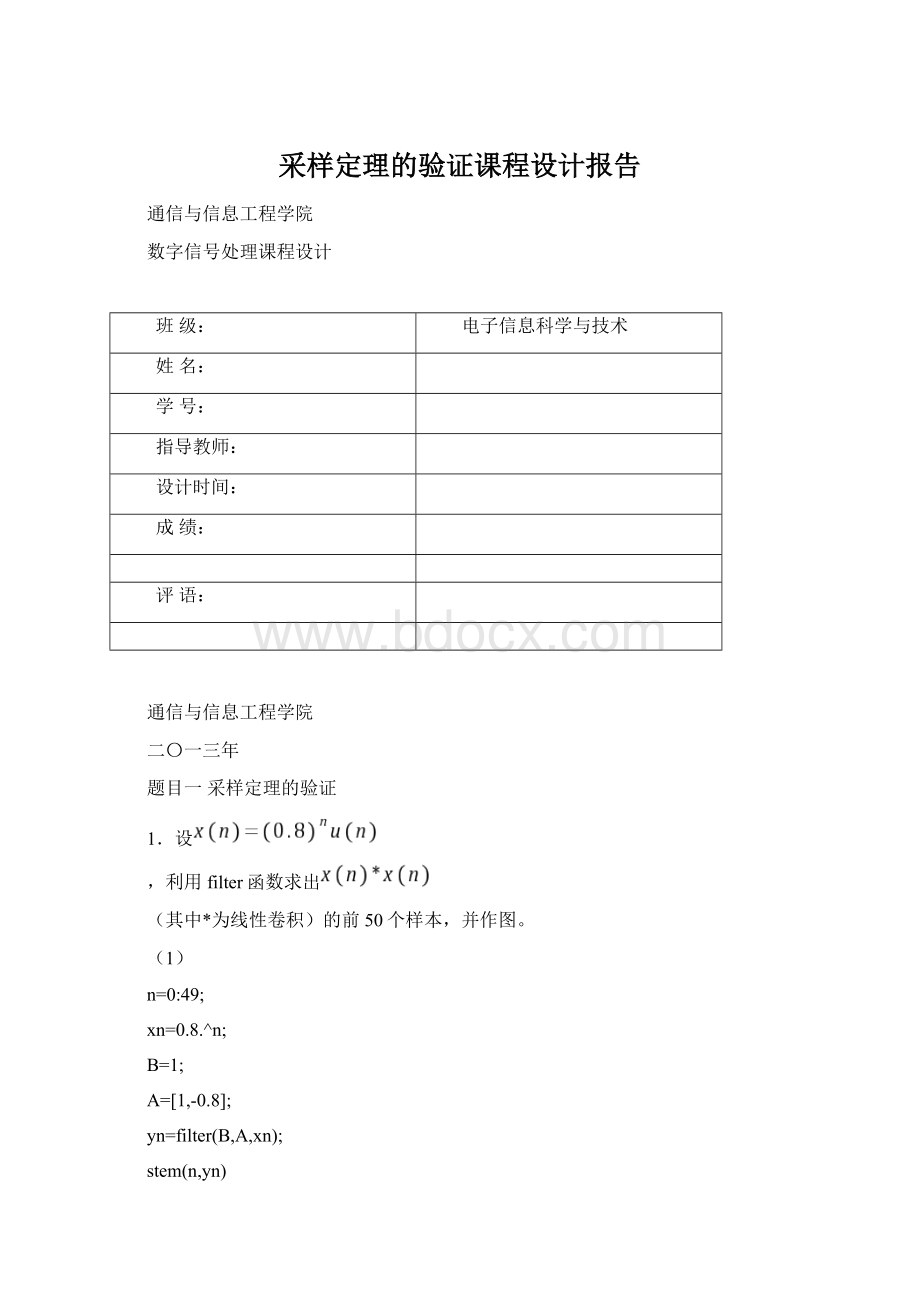采样定理的验证课程设计报告.docx
《采样定理的验证课程设计报告.docx》由会员分享,可在线阅读,更多相关《采样定理的验证课程设计报告.docx(23页珍藏版)》请在冰豆网上搜索。

采样定理的验证课程设计报告
通信与信息工程学院
数字信号处理课程设计
班级:
电子信息科学与技术
姓名:
学号:
指导教师:
设计时间:
成绩:
评语:
通信与信息工程学院
二〇一三年
题目一采样定理的验证
1.设
,利用filter函数求出
(其中*为线性卷积)的前50个样本,并作图。
(1)
n=0:
49;
xn=0.8.^n;
B=1;
A=[1,-0.8];
yn=filter(B,A,xn);
stem(n,yn)
gridon;
xlabel('n');
ylabel('yn=x(n)*x(n)')
2.考虑模拟信号
,
间隔采样得到
。
(1)对每一个
画出
。
(2)采用
内插从样本
重建模拟信号
,并从图中求出在
中的频率(不管末端效果)。
(3)采用三次样条内插从样本
重建模拟信号,并从图中求出在
中的频率。
(1)
clc;
t=0:
0.001:
1;Ts1=0.01;N1=1/Ts1;n1=0:
N1;
xn1=sin(20*pi*n1*Ts1);
subplot(3,1,1);
stem(n1,xn1,'.');axis([0100-11]);
xlabel('n');ylabel('x_1(n)');title('Ts=0.01');
t=0:
0.001:
1;Ts2=0.05;N2=1/Ts2;n2=0:
N2;
xn2=sin(20*pi*n2*Ts2);
subplot(3,1,2);
stem(n2,xn2,'.');axis([020-11]);
xlabel('n');ylabel('x_2(n)');title('Ts=0.05');
t=0:
0.001:
1;Ts3=0.1;N3=1/Ts3;n3=0:
N3;
xn3=sin(20*pi*n3*Ts3);
subplot(3,1,3);
stem(n3,xn3,'.');axis([010-11]);
xlabel('n');ylabel('x_3(n)');title('Ts=0.1');
(2)
t=0:
0.001:
1;T=0.1;
xt=sin(20*pi*t);subplot(4,1,1);plot(t,xt);
title('xt原图');xlabel('t');ylabel('xt');gridon;
Ts1=0.01;n1=0:
100;t1=0:
Ts1:
1;xn1=sin(20*pi*n1*Ts1);
tn1=ones(length(n1),1)*t1-n1'*Ts1*ones(1,length(t1));%ones(M,N):
生成M*N大小的全1矩阵
yt1=xn1*sinc(tn1*pi/Ts1);subplot(4,1,2);plot(t1,yt1);axis([01-11]);
title('sinc内插0.01恢复的xt1图');xlabel('n');ylabel('xt1');gridon;
Ts2=0.05;n2=0:
20;t2=0:
Ts2:
1;xn2=sin(20*pi*n2*Ts2);
tn2=ones(length(n2),1)*t2-n2'*Ts2*ones(1,length(t2));
yt2=xn2*sinc(tn2*pi/Ts2);subplot(4,1,3);plot(t2,yt2);axis([01-11]);
title('sinc内插0.05恢复的xt2图');xlabel('n');ylabel('xt2');gridon;
Ts3=0.1;n3=0:
10;t3=0:
Ts3:
1;xn3=sin(20*pi*n3*Ts3);
tn3=ones(length(n3),1)*t3-n3'*Ts3*ones(1,length(t3));
yt3=xn3*sinc(tn3*pi/Ts3);subplot(4,1,4);plot(t3,yt3);axis([01-11]);
title('sinc内插0.1恢复的xt3图');xlabel('n');ylabel('xt3');gridon;
(3)
Ts1=0.01;Fs=1/Ts1;
xa1=spline(Ts1*n1,xn1,t);
subplot(3,1,1);plot(t,xa1);axis([0,1,-1,1]);
ylabel('x_a(t)');title('Ts=0.01');
Ts2=0.05;Fs=1/Ts2;
xa2=spline(Ts2*n2,xn2,t);
subplot(3,1,2);plot(t,xa2);axis([0,1,-1,1]);
ylabel('x_a(t)');title('Ts=0.05');
Ts3=0.1;Fs=1/Ts3;
xa3=spline(Ts3*n3,xn3,t);
subplot(3,1,3);plot(t,xa3);axis([0,1,-1,1]);
ylabel('x_a(t)');title('Ts=0.1');
结果分析与体会:
采用
内插从样本
重建模拟信号
时,0.01s和0.05s依据奈奎斯特采样定理应该能恢复原来的波形,但因为采样点太少,间距分散导致0.05s时无法恢复。
题目二滤波器设计
设计内容:
一个混合正弦信号包含5Hz、15Hz、30Hz的3中频率信号,现要求分别设计滤波器,保留15Hz频率分量信号,给定采样频率100Hz。
(1)设计IIR型滤波器,分别用巴特沃斯型,切比雪夫型和椭圆型来实现。
(2)设计FIR型滤波器,分别用窗函数法、频率采样法和等波纹逼近法来设计FIR滤波器。
设计思考题:
1.不同方法设计的滤波器滤波性能的异同?
2.窗函数对滤波特性的影响,最优化设计中常用的逼近准则有哪些?
(1)
clear;closeall;clc
fs=100;
t=0:
1/fs:
1;
f1=5;
f2=15;
f3=30;
ys=sin(2*pi*f1*t)+sin(2*pi*f2*t)+sin(2*pi*f3*t);
subplot(311);
plot(t,ys);
wp=[11,18]*2/fs;
ws=[8,22]*2/fs;
Rp=2;Rs=50;
%设计模拟滤波器
[N,wc]=buttord(wp,ws,Rp,Rs);%求出滤波器阶数和2dB截止频率
[B,A]=butter(N,wc);%求零极点
yf=filter(B,A,ys)
subplot(312);
plot(t,yf);
gridon
[h,f]=freqz(B,A,1024,fs);%求数字滤波器频率响应
subplot(313)
plot(f,20*log10(abs(h)));axis([050-600100]);
grid;
xlabel('频率/Hz');ylabel('幅度/dB');
title('巴特沃斯滤波器');
(2)
clear;closeall;clc
fs=100;
t=0:
1/fs:
1;
f1=5;
f2=15;
f3=30;
ys=sin(2*pi*f1*t)+sin(2*pi*f2*t)+sin(2*pi*f3*t);
subplot(311);
plot(t,ys);
wp=[11,18]*2/fs;
ws=[8,22]*2/fs;
Rp=2;Rs=50;
[N,wc]=cheb1ord(wp,ws,Rp,Rs);
[B,A]=cheby1(N,Rp,wc);%切比雪夫I型
yf=filter(B,A,ys)
subplot(312)
plot(t,yf);
gridon;
[h,f]=freqz(B,A,1024,fs);
subplot(313)
plot(f,20*log10(abs(h)));
grid;
xlabel('频率/Hz');ylabel('幅度/dB');
title('切比雪夫滤波器');
(3)
clear;closeall;clc
fs=100;
t=0:
1/fs:
1;
f1=5;f2=15;f3=30;
ys=sin(2*pi*f1*t)+sin(2*pi*f2*t)+sin(2*pi*f3*t);
subplot(311);
plot(t,ys);
wp=[11,18]*2/fs;
ws=[8,22]*2/fs;
Rp=2;Rs=50;
[N,wc]=ellipord(wp,ws,Rp,Rs);
[B,A]=ellip(N,Rp,Rs,wc);
yf=filter(B,A,ys)
subplot(312)
plot(t,yf);
gridon;
[h,f]=freqz(B,A,1024,fs);
subplot(313)
plot(f,20*log10(abs(h)));
grid;
xlabel('频率/Hz');ylabel('幅度/dB');
title('椭圆型滤波器');
第二问
(1)
clear;closeall;clc
fs=100;t=0:
1/fs:
1;
f1=5;
f2=15;
f3=30;
ys=sin(2*pi*f1*t)+sin(2*pi*f2*t)+sin(2*pi*f3*t);
figure;subplot(211);
plot(t,ys);
axis([01-33]);
gridon
title('混合正弦信号图');
n=36;
Wn=[10,20]*2/fs;
b=fir1(n,Wn);
yf=filter(b,1,ys)
subplot(212)
plot(t,yf);
title('哈明窗滤波后15Hz正弦信号图');
gridon
axis([01-22]);
figure;freqz(b,1,512)
title('哈明窗带通滤波器');
(2)
clear;closeall;clc
fs=100;t=0:
0.01:
pi/5;
y=sin(2*pi*5*t)+sin(2*pi*15*t)+sin(2*pi*30*t);
fs1=8;fp1=11;fp2=18;fs2=22;
ws1=fs1*2*pi/fs;wp1=fp1*2*pi/fs;
wp2=fp2*2*pi/fs;ws2=fs2*2*pi/fs;
m=1;n=41;N=(n-1)/2;
n1=fix(wp1/(2*pi/n));
n2=fix(wp2/(2*pi/n));
n3=n2-n1;
n4=n-n2;
t1=0.1;
Hk=[zeros(1,n1),t1,ones(1,n3),t1,zeros(1,n4-2)];
k1=0:
floor((n-1)/2);k2=floor((n-1)/2)+1:
n-1;
angH=[-N*(2*pi)/n*k1,N*(2*pi/n*(n-k2))];
H=Hk.*exp(j*angH);
hn=real(ifft(H));
figure;freqz(hn);
axis([01-1000]);
title('频率采样带通滤波器');
y2=filter(hn,1,y);
figure;subplot(2,1,2);plot(t,y2);
title('频率采样滤波后15Hz正弦信号图');xlabel('t');ylabel('yt1');gridon;
subplot(2,1,1);plot(t,y);
title('混合正弦信号图');xlabel('t');ylabel('yt');gridon;
(3)
clear;closeall;clc
fs=100;t=0:
0.01:
pi/5;
y=sin(2*pi*5*t)+sin(2*pi*15*t)+sin(2*pi*30*t);
fs1=8;fp1=11;fp2=18;fs2=22;
ws1=fs1*2/fs;wp1=fp1*2/fs;
wp2=fp2*2/fs;ws2=fs2*2/fs;
f=[ws1,wp1,wp2,ws2];
m=[0,1,0];
Ap=1;As=40;
dat1=(10^(Ap/20)-1)/(10^(Ap/20)+1);dat2=10^(-As/20);
rip=[dat2,dat1,dat2];
[M,fo,mo,w]=remezord(f,m,rip);
M=M+1;
hn=remez(M,fo,mo,w);
y2=filter(hn,1,y);
figure;subplot(2,1,1);plot(t,y);
title('混合正弦信号图');xlabel('t');ylabel('yt');gridon;
subplot(2,1,2);plot(t,y2);
title('等波纹逼近滤波后15Hz正弦信号图');xlabel('t');ylabel('yt1');gridon;
figure;freqz(hn);title('等波纹逼近带通滤波器');
题目三:
语音信号滤波处理
设计内容:
1.利用Windows下的录音机录制一段带有噪声的话音,时间在1s内。
然后在Matlab软件平台下,利用wavread函数对语音信号进行采样,记住采样频率和采样点数;
2.画出语音信号的时域波形,对采样后的语音信号进行傅立叶变换,得到信号的频谱特性,画出频谱图;
3.根据对语音信号谱分析的结果,确定滤除噪声所需滤波器的技术指标,设计合适的数字滤波器,并画出滤波器的频域响应;
4.用所设计的滤波器对采集的信号进行滤波,画出滤波前后信号的时域波形和频谱;
5.回放语音信号;sound(x)
设计思考题:
(1)语音信号频率的范围?
(2)滤波前后信号有什么变化?
%语音信号的时域和频域波形
[y,fs,bits]=wavread('Yangxue.wav');
sound(y,fs,bits);
[a,b]=size(y);
Y=fftshift(fft(y(500:
1000)));
subplot(211);plot(y);
title('原始信号波形');
k=0:
500;
f=(k/500)*fs;
subplot(212);plot(f,abs(Y));
title('原始信号频谱');
%语音信号的时域和频域波形
[y,fs,bits]=wavread('Yangxue.wav');
sound(y,fs,bits);
[a,b]=size(y);
Y=fftshift(fft(y(500:
1000)));
subplot(211);plot(y(500:
1000));
title('原始信号波形');
k=0:
500;
f=(k/500)*fs;
subplot(212);plot(f,abs(Y));
title('原始信号频谱');
%用双线性变换法设计IIR低通滤波器
fp=1000;fc=1200;As=100;Ap=1;
fs=22050;
wc=2*fc/fs;
wp=2*fp/fs;
[n,wn]=ellipord(wp,wc,Ap,As);
[b,a]=ellip(n,Ap,As,wn);
freqz(b,a,512,fs);
[y,fs,bits]=wavread('Yangxue.wav');
sound(y,fs,bits);
[a,b]=size(y);
Y=fftshift(fft(y(500:
1000)));
subplot(211);plot(y(500:
1000));
k=0:
500;
f=(k/500)*fs;
title('原始信号波形');axis([0,499,-1,1]);
subplot(212);plot(f,abs(Y));
title('原始信号频谱');axis([0,499,0,19]);
%用双线性变换法设计IIR低通滤波器
fp=1000;fc=1200;As=100;Ap=1;
fs=22050;
wc=2*fc/fs;
wp=2*fp/fs;
[n,wn]=ellipord(wp,wc,Ap,As);
[b,a]=ellip(n,Ap,As,wn);
freqz(b,a,512,fs);
%对原始语音信号滤波后的时域与频域波形
y1=y(500:
1000);
x=filter(b,a,y1);
X=fftshift(fft(x));
subplot(211);plot(x);title('滤波后信号波形');axis([0499-11]);
subplot(212);plot(abs(X));title('滤波后信号频谱');axis([0499019]);
题目四:
雷达信号的仿真
设计原理:
雷达系统中常用的雷达信号是线性调频信号,
,其中k为调频率。
假设信号的持续时间为
,信号带宽为
,则调频率为
。
在matlab中表示线性调频信号,必须对s(t)进行采样。
设计内容:
(1)产生线性调频信号,信号的持续时间
,信号带宽
,其采样率
,并给出其频率特性。
(2)在
(1)的基础上,将采样频率变为
,其余特性不变,产生线性调频信号及其给出其频率特性并与
(1)所比较。
(3)将
(1)所产生的线性调频信号通过一个匹配滤波器,给出输出结果。
(4)在信噪比
两种情况下,给出匹配滤波器的相应结果。
(1)
T=25e-6;
B=30e6;
K=B/T;
Fs=2*B;Ts=1/Fs;
N=T/Ts;
t=linspace(-T/2,T/2,N);
St=exp(j*pi*K*t.^2);
subplot(211)
plot(t*1e6,St);
xlabel('Timeinusec');
title('采样频率2B时线性调频信号');
gridon;axistight;
subplot(212)
freq=linspace(-Fs/2,Fs/2,N);
plot(freq*1e-6,fftshift(abs(fft(St))));
xlabel('FrequencyinMHz');
title('线性调频信号的幅频特性');
gridon;axistight;
(2)
T=25e-6;
B=30e6;
K=B/T;
Fs=1.5*B;Ts=1/Fs;
N=T/Ts;
t=linspace(-T/2,T/2,N);
St=exp(j*pi*K*t.^2);
subplot(211)
plot(t*1e6,St);
xlabel('Timeinusec');
title('采样频率1.5B时线性调频信号');
gridon;axistight;
subplot(212)
freq=linspace(-Fs/2,Fs/2,N);
plot(freq*1e-6,fftshift(abs(fft(St))));
xlabel('FrequencyinMHz');
title('线性调频信号的幅频特性');
gridon;axistight;